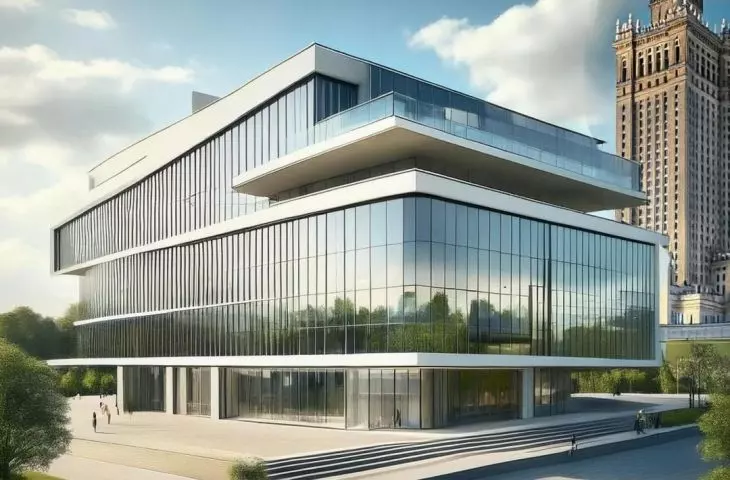Year after year, the topic of artificial intelligence is increasingly engaging the mainstream media, becoming the theme of scientific conferences and TV and radio programs. It is hardly surprising, since AI algorithms are now influencing almost every sphere of human activity. It is no different in the case of architecture - what consequences will the use of AI have for the future of construction?
In recent days, Polish public opinion was shaken by the news of the situation that took place at Off Radio Krakow. As Mateusz Demski reported on his social media profile, the station's management decided to make a bold move - on the air appeared broadcasts entirely conducted and prepared by digital "avatars", generated through the use of artificial intelligence. During the broadcasts, one can hear not only the new editors and editor, but also prominent cultural figures, such as Wislawa Szymborska, who commented in a savage tone on this year's Nobel Prize in Literature. Artificial intelligence-generated bots replaced journalists and female journalists who had been working with the radio station for several years running broadcasts. Journalism is not the only field in which Artificial Intelligence is replacing living people. In recent days, Jaroslaw Juszkiewicz, who had been the Polish voice of Google Maps for years, said goodbye to Polish women and men. The technological revolution has not spared architecture. How are digital artificial intelligence algorithms being used in architecture? Will AI replace living architects, and finally - thanks to AI, will Le Corbusier, who died almost 60 years ago, design our next buildings?
A man using AutoCad (1978)
Photo: Evergreen Systems ©public domain | Wikimedia Commons
up close and personal with technology
The role of new technologies in modern architecture is invaluable. The introduction of tools and digital support methods such as CAD, Revit and, more recently, BIM has greatly increased the range of design possibilities, streamlined the process and allowed far-reaching optimization of the results achieved. Things are similar with artificial intelligence algorithms, which have been used in design for a good few or even a dozen years now. Tools based on machine learning are incomparably faster, and often better and more accurate than humans in developing the technical characteristics of the designed objects, for example, the application of pro-environmental solutions, the development of individual structural issues or optimization of space utilization.
They can alsobe an invaluable aid in the conceptual phase of the design process - such practices are now increasingly used by architectural studios, for some, such as Zaha Hadid Architects and Foster + Partners, generators of images and even entire buildings have become an essential tool in the early stages of design, used in place of sketches made with a piece of paper and pen.
Le Corbusier's building concept for the Museum of Modern Art in Warsaw - Generated using DALL-E 3.0
Artificial intelligence helps visualize even the boldest concepts in the blink of an eye - in the face of the incomprehensible wave of criticism that the new building of the Museum of Modern Art in Warsaw is facing, I decided to ask AI to generate an image depicting the MSN building designed by Le Corbusier. The tool I used, although not intended for architectural design, was able to propose a concept that is roughly based on the superficially understood principals that governed Corbusier's architecture. However, the results of this innocent game are symptomatic of an important phenomenon, related to copyright and, by extension, creativity. All artificial intelligence models are "trained" on the data provided to them. In the case of architecture, this data is already existing construction projects and architectural realizations, often obtained without the authors' permission. In addition, generating ideas based only on already established concepts implies a certain duplicity that can drive architecture into a vicious circle.
Zaha Hadid's buildings in the desert - Generated using Stable Diffusion
matankic © CC BY SA 4.0 | Wikimedia Commons
everyone has AI, I do too
Even so, artificial intelligence is already one of the primary tools used by architects. According to data collected in this year's RIBA AI Report 2024, artificial intelligence is used in their work by as many as 41% of respondents. However, it should not be overlooked that only 2% of those asked use AI in all their projects, and 4% in most of them. The largest group (21%) uses AI only occasionally.
Architecture 'solar punk'
Prototyperspective © CC 1.0
Artificial intelligence, however, is having a negative impact on the mood of the architecture profession. According to the same report, the majority (56%) of male and female architects believe that AI will make them earn less in the future. Nearly half (46%) fear that new technologies based on machine learning will reduce the number of job opportunities available on the market. This process is already slowly progressing, as the results of RIBA's survey indicate that 7% of offices that employed respondents had job cuts due to the increased use of AI in design.
The advancing digitization also raises a number of concerns about other areas related to architecture. As many as 56% of those questioned believe that the use of AI in design increases the chances of committing plagiarism based on concepts they have created, and 36% see the development of AI as a threat to the future of the profession. Architects also see negative consequences of the increased use of AI in the field of professional ethics. Those surveyed were most likely to point to problematic aspects of using AI in relationships with clients (27%), the community (27%) and friendly architects (26%).
Block concept generated using the phrase "affordable housing" - Generated using Adobe Express
machine crash
We are slowly getting used to a world in which various content is generated autonomously by AI, without significant input from people to oversee its operation. Already, the Internet is bursting at the seams with AI-generated texts that are not only of low quality, but also often misleading. As a 2024 study by Amazon Web Services showed, more than 57% of the content we can find online has been generated or translated using AI algorithms, and AI experts predict that by the end of 2026, as much as 90% of content on the Internet will be created using AI.
It's hard to imagine that there will be adequate supervision over the creation and publication of all this material, after all, one of the main "advantages" of digital brains is the reduction of the need for time and human resources during work. Online, for example, we can already watch programs such as "Nothing, Forever," an artificial intelligence-generated sitcom that has been broadcast 24 hours a day since the end of 2022. The use of the phrase "non-stop" would be an abuse here, however. From February 6 to March 23, the broadcast of the series was suspended because one of the characters appearing on the virtual stage "decided" to hurl unfunny jokes with trans and homophobic undertones at the audience. Such "mistakes" can be more or less serious in their consequences. In the case of architecture, we may have to deal with consequences that will affect the environments in which we operate for years to come.
Paragraph under the digital creation
In an ideal world, representatives of all professions, including architects, would always conduct business based on the highest ethical standards. However, we know from practice that this is not always the case. In June of this year, the Pomeranian Chamber of Architects of the Republic of Poland published an "instruction" on its profile, which warns practitioners of the profession of the consequences of signing projects at the creation of which they did not participate. As Maria Korcz showed in her column, there are people in Poland who sign as many as 300 construction projects each year. Leaving aside authorship issues, conclusions about the reliability of "checking" such projects come to mind.
It is not difficult to imagine that in the (near?) future there will be people who will similarly authorize concepts generated largely or even entirely using artificial intelligence. The availability of advanced tools that can generate full design documentation for buildings in a matter of hours raises concerns that such buildings may soon begin to be built in much greater numbers than we would like. Or is that already the case? Unlike digital content, which with proper (funnily enough, also carried out thanks to artificial intelligence) analysis can be unmasked as AI creations, material objects based on concepts generated by artificial intelligence are much harder to distinguish from creations created solely by human labor.
Le Corbusier's building concept for the Museum of Modern Art in Warsaw.
Generated using Adobe Express
AI in architecture - an opportunity or a threat?
As in all fields into which the application of artificial intelligence has impetuously entered, architectural design can significantly gain on many levels thanks to the availability of new tools. AI algorithms make it possible to process huge amounts of information quickly, analyze accurately and generate visions of new concepts instantly. However, it seems that, like other areas of human (and now rather computer) activity, architecture is equally vulnerable. The first "disasters" related to the use of AI are already happening - people are dying in accidents involving autonomous cars, many industries are experiencing sharp job cuts, and art contests are being won by images created with graphics generators. Will there come a time for an AI-related architectural disaster? Certainly, and since further implementation of AI-based solutions in design processes seems inevitable, we should prepare for such situations as best we can and approach any AI-served solutions with caution. Awareness of this threat may in turn become an important guarantor of the future of the architectural profession.








































